Prospectus Paper & Completed Solo MFA Thesis Show Works
Originally posted Jan 26, 2021.
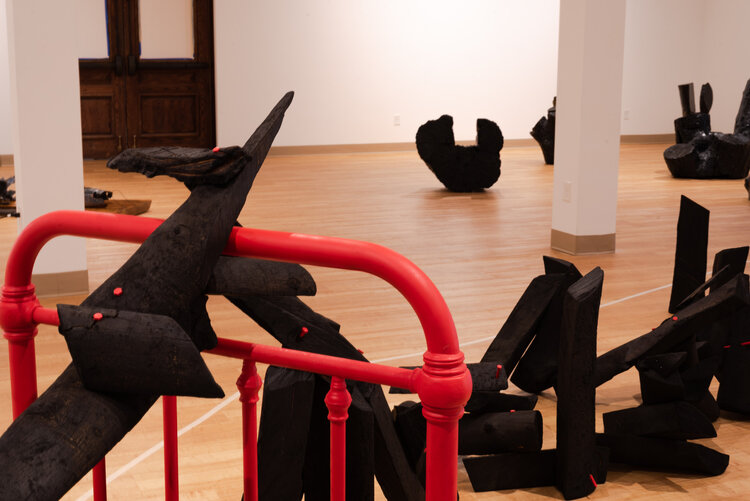
A Whimsical Horror, Sideview, Daniella A. Colombo-Dougovito, Fall 2019.
Sanative Refraction
By Daniella A. Colombo-Dougovito, MFA
Problem Statement
Sanative Refraction is a personal exploration of the potential for healing, empowerment, and transformation when art is used to facilitate cognitive retraining to recover from Post Traumatic Stress Disorder (PTSD) and Severe Anxiety and Panic Attack Disorder. This exhibition of artwork will be composed of large-scale amalgamations: Sculpture, photography, and encaustic paintings will serve as physical representations of my healing process.
Purpose Statement
When a catastrophe occurs in an individual’s life and that individual is not afforded the opportunity to process the event(s), the physical and emotional trauma alter the pain receptors in the brain, which increases the risk of triggering PTSD as the “emotional wound festers” (Bovin et al., 2016). In this constant hyper-reactive state, a person is likely to experience harrowing flashbacks, which in turn increase the potential for further physical and emotional injury. In reliving the trauma, the distinction between reality and memory is blurred until the flashback is over.
Sanative Refraction is a personal journey into the healing process that explores the connection of memory and reality and the subsequent disconnection. By separating the mind from self—memory from reality—in a state of pure difference, the mind is allowed to be in an authentic moment before the signifier and signified (Delueze, 2014, p. 132). My work, like the state of pure difference, dives into the space before the brain recognizes intention (signifier)⎯the space in between⎯where my mind is separated from the actions of creation my body is performing. This space is where memory and reality converge (signified), and therefore it creates a space for healing through the act of creation. Through the combination of photography, sculpture, paint, and poetry, the viewer will be confronted with a physical and painful, yet cathartic, deconstruction of the memory and a reconstitution of the healing process. By abstractly photographing, burning, and painting the memories of my traumas, I visually represent the reconstruction of my pain during the healing processes. The pain, anger, and rage will be represented through fire, burning, melting, and other techniques I use to create this body of work. Artwork in this series will represent the daily struggles of coping with the past and what it means for my journey to healing in the future. By connecting with the essence of the emotions experienced during this process, this series seeks to impart, on a visceral level, varying psychological and metaphysical responses in the viewer as they experience my process of healing, as demonstrated by the raw product of the work I will create.
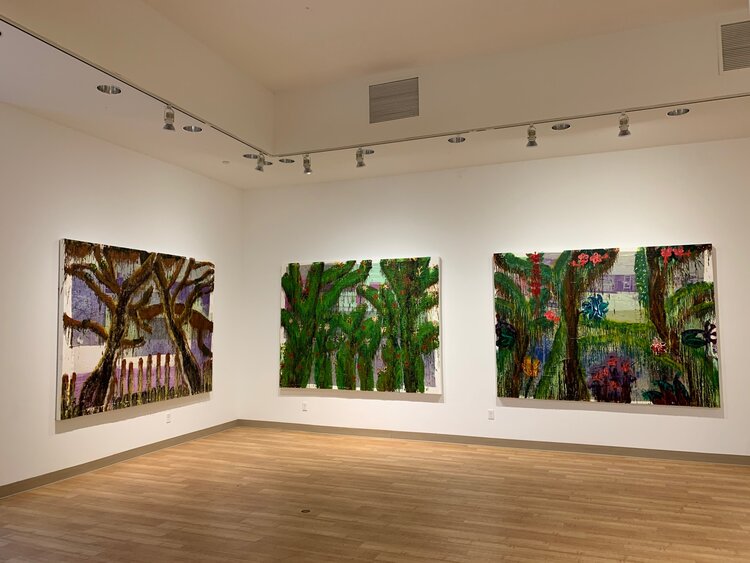
Winter to Summer Series; Encaustic Paintings with Film Photographs (Mixed Media), Daniella A. Colombo-Dougovito, Fall 2019.
Significance Statement
The intrusive reflections, flashbacks, and nightmares that coexist with trauma are of great interest and expressed in the following ways in Sanative Refraction: (a) anger, anxiety, and healing grief through charred wood; (b) tears of joy and sadness in different patinas; © encaustic pigments—browns to blues to yellows, winter to summer—as an abstract reference to psychological healing; (d) photography that captures the brief pauses to breathe, and (e) my poetry, for deeper contemplation. As a whole, Sanative Refraction is a way to further help me process the extremely heightened emotions I have had to find a way to coexist with. For instance, heightened arousal often causes immense anxiety when leaving my house to be around others in public. Through Sanative Refraction, I will represent the stages of my mental state as I begin to recognize—through each brush stroke, every layer of encaustic pigment—that there is beauty in life at all stages, and that integration back into society will be okay. Ultimately, I will be okay, I will heal, and I will survive. Focusing completely on the process of this work—such as creating a photograph of a personal moment and concentrating on nothing except what is inside the frame —allows me to be comfortable with the possibility that everything will be okay. The resulting pieces are physical representations of capturing these moments—moments associated with past trauma or previous pain—and reconstructing them to represent new, stronger memories.
Spattered on every page of our collective history is evidence of constant battles waged. We have fought for land, for resources, for life, to protect those we love, and to survive. These past battles are not unlike our current tragedies, and with them coexist the experiences of those who have experienced the greatest traumas. In 400 B.C., Greek historian Herodotus wrote an account of one such person, an Athenian named Epizelus who suddenly lost his eyesight in the midst of battle when he witnessed an ally being killed in combat. He remained sightless for many years. Herodotus stated that this “blindness” was not due to a wound, but occurred because of the trauma Epizelus had witnessed (Felton, 2014). Later, Hippocrates recollected soldiers having “night terrors” of the battles they had fought and survived (Hempel, Felthous, & Meloy, 2003). The Icelandic Saga of Gísli Súrsson describes post-battle nightmares. Ramayana, an Indian text dating to approximately 2,500 years ago, depicts the demon Marrich suffering from hyper- reactive states, reliving the trauma he survived, and exhibiting extreme avoidance behavior—all common symptoms of PTSD.
Numerous cases of individuals presenting with extreme despair and anxiety were reported in Europe in the 1600s, and Dr. Johannes Hofer of Switzerland (Battesti, 2016) is credited with naming the condition “nostalgia.” Similar cases were being diagnosed simultaneously by unconnected doctors in Germany, Spain, and France when examining their military patients. Josef Leopold Auenbrugger, an Austrian physician, also wrote about this sickness in trauma-ridden soldiers in Inventum Novum.(Auenbrugger, 1966). During the U.S. Civil War, “nostalgia” (e.g., PTSD) was commonly diagnosed. Not until the First World War was the terminology changed from “nostalgia” to “shell shock,” and later to “battle fatigue” or “combat fatigue” during the Second World War (Mott, 1919). In 1968, the diagnosis of combat fatigue was removed from The Diagnostic and Statistical Manual of Mental Disorders (2nd ed.; DSM-II, American Psychiatric Association [APA], 1968), thereby limiting veterans’ ability to receive treatment. In 1980, the APA published the DSM-III, which recognized PTSD as a diagnosis. Moreover, it was recognized that PTSD could occur outside of military settings; survivors of rape, child abuse, assault, serious illness, and other traumatic events were all at risk for developing symptoms.
Immense anxiety arises from being diagnosed with an unseen disability. To others you may seem okay or “normal,” because your trauma is not visible; yet PTSD can be a debilitating disability that many struggle with daily. The constant anxiety of possibly having an attack, hurting yourself, not being safe, or someone trying to hurt you when this occurs is an ever present struggle. I find relief in the bending, hammering, burning, cutting, and charring of the materials used in Sanative Refraction. I go into a flow state that enables me to just be present and find solace. This inherently renders Sanative Refraction an ideal project for me to continue my journey of healing. The separation of hyper anxieties allows me to recognize that what I feel is rationally irrational because of what I have survived—but also that history is not doomed to repeat itself, and through my work I can continue to heal while achieving a new normalcy.
As the terminology evolves, the symptoms remain the same (e.g., anxiety, exhaustion, flashbacks, night terrors, and loss of hearing and/or eyesight), although they vary in magnitude. Society’s method of treatment has continued to evolve as knowledge about the condition has grown to best meet patients’ needs. Yet little academic or therapeutic attention has been paid to art therapy and its potential ability to aid in the recovery process as a tool to help “re-normalize” the brain. An analysis of the use of art therapy by Schouten et al. (2015) reports positive outcomes by demonstrating “a significant decrease in psychological trauma symptoms” and depression (Schouten et al., p. 1).
Art, as a cathartic process, has the ability to cross cultural, religious, medical, and hierarchical borders. This allows the viewer to witness the results within the work and the positive effects on the artist. Scores of artists have captured the internal and external struggles of mental illness, yet many are not able to extend the process beyond trauma to healing by starting the therapy process.
Sanative Refraction is the physical representation of my exploration of healing through creation. The combination of multiple art mediums and processes, both representative and abstract, depicts the separation of memory and reality and its subsequent reconstruction. This work will highlight internal conversations about reconciliation and acceptance of past events to reach a place of acceptance and healing. By blurring the lines between photography, sculpture, paint, and poetry, viewers will be immersed in a multimodal dialogue with healing and creative processes. The work’s visceral quality confronts the viewer and asks them to reconsider their preconceptions about victims of trauma. Through the viewing process, ideally, the viewer will leave with greater empathy for the human experience of trauma, as well as the ability to find the strength we all possess in order to process and handle it in a healthy way.
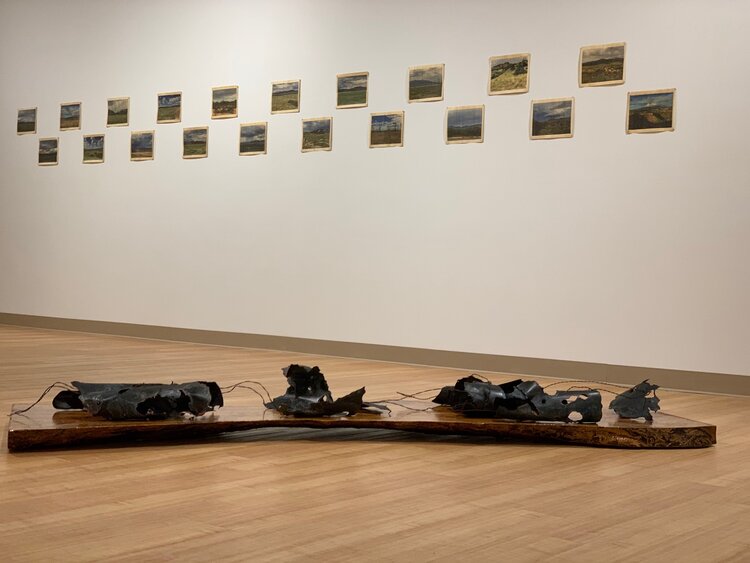
Transformative Perceptions (Above) & What Remains Behind (Below), Sideview, Daniella A. Colombo-Dougovito, Fall 2019.
Literature Review
A number of artists have informed this body of work, including Jeremy Deller, Michael De Feo, Sally Mann, Rebecca Norris Webb, N. Teddy Goldsworthy-hanner, John William Keedy, Rinko Kawauchi, and Charles Burchfield. I will explain in some detail how each artist affects my creative processes. Love, loss, heartache, dream states, and healing are central themes of myriad artists working across the artistic disciplines of visual art and literature. The artists I have chosen have had a profound impact not only on how I view the art-making process, but on life and healing as a whole.
Only recently have contemporary artists such as Edward Honaker, John William Keedy, Katie Joy Crawford, and Mary F. Calvert openly created work about anxiety and PTSD as it relates to sexuality, gender, and healing. Clavert’s documentary photographic series focuses on rape survivors in the military (Calvert, 2016). This recent refocusing of contemporary issues has further pushed the work of Barbara Kruger into more contemporary concentration of art as social commentary and as activism to the forefront of importance in our currently evolving culture. Few artists have broached this topic as a self-identified survivor and used their work to guide the viewer through the personal and volatile healing process, which I will do in this project.
Sally Mann’s photographs capture the raw emotion of her subject matter. Through the lens, Mann has influenced my art; I too write poetry during my physical creation processes. Sanative Refraction will be influenced by the process of writing and creating, similar to what Mann undertook in her 2006 series, Photographs and Poetry. Mann started her visual art production with poetry. For example, she wrote (Mann & Wood, 2005):
To evoke what, like a dream, was lost only seconds ago, only decades ago,
To recover and clarify the deposits, grace so fragile, so various.
This poem is paired with an image of a white sheet pulled up between a pair of closed thighs to cover a woman’s vagina, using a tight crop and straight-on vantage point. After each poem, the paired images are psychologically moving and deeply contemplative. This process of writing before and during creation has heavily influenced my creative processes during my MFA work and will continue to do so for Sanative Refraction.
Rebecca Norris Webb was originally a poet and became a photographer after realizing that she could create imagery based on her poetry and vice versa. This realization came after a year-long trip, as she traveled with a camera to work through the writer’s block she had been struggling with since finishing school. Norris Webb’s Ghost Mountain from My Dakota (2012) is particularly inspirational, as Norris Webb created it to process the loss of her brother, to help make sense of this loss, and to begin to heal (Webb & Norris Webb, 2014). Ghost Mountain is a street photograph of a garage door that has a mountain and tree cover painted on the surface. There is a delicacy to the framing of the garage door, demonstrated through the soft, bright, diffuse natural lighting; this delicacy is something I will seek to emulate in some of my own imagery, as well as the delicacy of how Webb writes her poems and pairs them with the images.
As a part of my own healing process, I have written poetry as an outlet. I have captured night terrors, flashbacks, and panic attacks in the subsequent moments when trauma is relived as a way to further process the severe trauma I have survived. Throughout Sanative Refraction, text will be paired with the created pieces to guide the audience’s psychological dialogue. The dialogue between my written word and sculpture will seek to focus attention on the external societal stigmas attached to being a severe trauma survivor who is recovering and learning to live with PTSD.
Michael De Feo’s art as social commentary directly relates to his desire for adults and children to rediscover their surroundings and gain a fresh perspective on how they view the world through his Alphabet City (2005) street art (C100, 2006). Each image is documentary street photography that pairs well with his mental model (i.e., social commentary) and use of aesthetics to grab the attention of children and allow adults to consider a different perspective.
Like De Feo, Sanative Refraction will present a personal journey of healing that is not often represented. By blurring the multitude of included media in a unique way, viewers will be immersed in the series and compelled to contemplate their preconceptions of trauma and healing. In doing so, Sanative Refraction will provide the space needed to allow individuals to question their own beliefs and, in turn, connect with the process of healing from trauma in their own way.
Jeremy Deller is a multimedia artist whose work falls within the realm of art for activism and social commentary. Deller’s presentation of a car that had been bombed in a popular Baghdad market on Al-Mutanabbi Street demonstrates how a dialogue within the viewer in a safe space allows contemplation of the war and its impact. It Is What It Is: Conversations about Iraq (Thompson, 2015) breaks down the cultural barriers and stigmas that accompany being an American from the Middle East. This piece, and its presentation with open space around it, encourages open, free-flowing dialogue among its viewers. Deller’s hope was that his piece would be experiential for the viewer and not merely didactic by bringing a piece of the bombed-out truck back from Iraq and displaying it. This offered people the freedom to ask questions about sensitive subject matter. Through activism and art, and in a “safe-yet-confrontational” manner, Deller was able to break down societal and cultural barriers to encourage viewers to have increased compassion for the subject matter.
The texture and depth shown in the work of N. Teddy Goldsworthy-hanner has inspired me to recreate this technique using the encaustic medium in Sanative Refraction. This medium adds emphasis to the literal subject matter within each frame, thereby propelling each individual concept forward. Goldsworthy-hanner’s Arbitrary Memories (2006) demonstrates how photographs can be married with mixed media to represent not only beauty, but also memory and strength. Goldsworthy-hanner uses everything she has experienced in life, on a very personal level, in each of her pieces—not only as an outlet, but also as a way to find beauty within herself as a woman and the life around her. Further, Goldsworthy-hanner attempts to break down the discourse of difference to yield a “positive different” (Goldsworthy-hanner, 2016) through her work, with the goal of effecting social change by helping individuals understand one another. By “a reawakening of our higher natures, we should and can rectify our relationships” because “it is the balance that ultimately will sustain us” (Goldsworthy-hanner, 2016).
John William Keedy, through his linguistically based concept, creates images that allow the viewer to understand what it is like to live with anxiety and panic attacks. In It’s Hardly Noticeable (Keedy, n.d.), he is able to capture the unseen—i.e., the emotions that are at the root of outward observed behavior. Throughout this series, he captures how anxiety can dictate daily life and the strategies to exert control over these behaviors (“John William Keedy’s It’s Hardly Noticeable”, 2013). Further, Keedy demonstrates how the control one attempts to exert can spur greater “rationally irrational” fears and anxiety that surpass the standard definition of anxiety: “a feeling of worry, nervousness, or unease, typically about an imminent event or something with an uncertain outcome” (Oxford University Press, 1982). Through the use of repetitive elements in his images, the viewer is given a window into various coping mechanisms for anxiety. The task repetition Keedy depicts shows how a person with anxiety may try to gain control in a world in which the lack of control is ever present (“John William Keedy’s It’s Hardly Noticeable”, 2013).
Trying to gain control and be comfortable around people is a constant struggle. My work, including Sanative Refraction, helps me process my traumas the way Keedy’s work did for him. Burning, bending, and melting help me gain control over the “rationally irrational” and adjust to being around people. The repetition of passing the torch and open flame across wood in Shou Sugi Ban, an ancient Japanese firing technique, produces a cathartic black char on the wood to depict an attempt to control anxiety. My use of repetition in my creative, aesthetic, artistic, and conceptual choices in my photography will and have been a way I gain control.
The concept of being alive in the moment dominates Rinko Kawauchi’s work. In The river embraced me (2016), Kawauchi created a series of documentary images inspired by memories of the people who live in Kumamoto, Japan (Dayman & Sandrey, 2018). In capturing these wild, intense memories in a single photograph, Kawauchi takes the viewer on a journey into vivid scenes full of flowers, forests, roads, and, most importantly, life.
Kawauchi’s commanding use of imagery to recreate memories is part of my inspiration to create the imagery that will be used in Sanative Refraction. The images used throughout my series recreate an anti-anxiety technique called “Five Things” by documenting what is seen while managing PTSD symptoms. This exercise helps anxiety and PTSD patients reduce and prevent symptoms. The process, which involves focusing on five available objects, repeating their names, and counting down five to one, lowers the heart rate and can prevent full panic attacks and episodes. Using a similar framework, I will abstractly represent the counting and control in the series. Images are captured from behind the lens while working through this strategy and as retroactive reconstructions, allowing reflection on the self-analysis of memory.
Inspired by the works of abstract painter Charles Burchfield, who represents landscapes and seasons, I will use seasons as a metaphor for transformation and healing. In works such as Spring Landscape with Trees and Pond (1947), Burchfield’s work elicits calm and healing through the use of mainly gray variations, with slight specific bits of subdued color to illustrate the beauty of the passing seasons (Weekly, 1993). Burchfield elegantly portrays the seasons as plants grow, die, and come back to life. Sanative Refraction is a visual journey through the deconstruction of memory and the reconstitution of self; using Burchfield as a guide to demonstrate melancholy emotions, the pieces in the series will blend imagery, sculpture, and encaustic to give the viewer insight into healing after trauma and leave space for the viewer to journey within themselves to understand what is possible.
As a result of these artists’ creative actions, their pieces represent pain and become a site of healing—not just for themselves, but also for those who directly interact with them. Viewers of Sanative Refraction will be afforded a similar space to confront the taboos of mental health and sexual/physical trauma. By presenting imagery, sculpture, painting, and text within an immersive space, with space between each piece, I will create room for an open dialogue between all present.
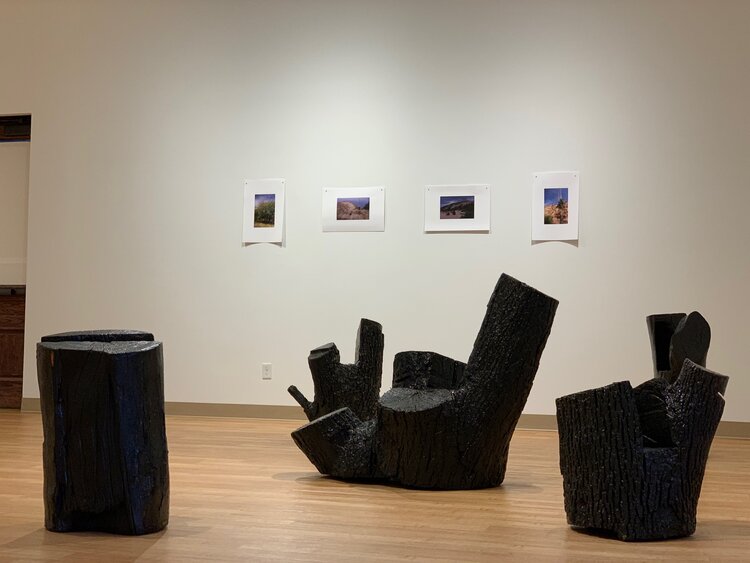
Amended Equilibrium (Above) & Bases 1-6 (Below), Sideview, Daniella A. Colombo-Dougovito, Fall 2019.
Methodology
Sculpture in this series will consist primarily of wood and metal. The incorporated wood will feature the use of Shou Sugi Ban and be sealed with a combination of vegetable oil and urethane. Several large-scale paintings incorporating photographs shot on film and printed on silk will be included; the images will be fused to the canvas using an encaustic medium and strategically painted over with encaustic pigment. To create work that captures both the range of emotions and the intangible experiences of the event—yet also presents past trauma in a contemplative, healing fashion—I will start with words and present them, as Mann has, juxtaposed with my visual creations. This will occur through the actual space in between pieces, which will serve as a pause, enabling the viewer to consider each piece. The healing pauses will be represented through the combination of the actual space, the written words next to pieces, and use of the calming, cool tonal values of blue patinas and other colors. Sanative Refraction will seek to effect change—for the better—in viewers by demonstrating abstractly the changes of seasons that represent new growth and healing (winter-summer). Lastly, the space will be tailored to further the concept of healing through art by creating a journey that is immersive for the viewer.

A Whimsical Horror (Floor) & Transformative Perceptions (Wall/partial view), Sideview, Daniella A. Colombo-Dougovito, Fall 2019.
Limitations
Sanative Refraction is an exhibition that will feature numerous large-scale sculptures with the maximum size being 10’ x 20’ and the smaller being 4’ x 4’ approximately. There will be two or three large-scale 72” x 96” paintings. These paintings will contain numerous film photographs that I have printed on 6’ x 5’ silk and fused to the canvas using encaustic medium and painted with encaustic pigment. The paintings will be supported by sculptural bases I will carve, and will allow them to be free standing in space. An element of poetry will be incorporated in all of my work. Poetry will be directly inserted into the gallery space, and will be written by myself with the possibility of an oral recorded presentation over a speaker. There will also be cast resin sculptures, varying from 1’ x 6” to 4” x 4”, and sculptures made of photographs I create.
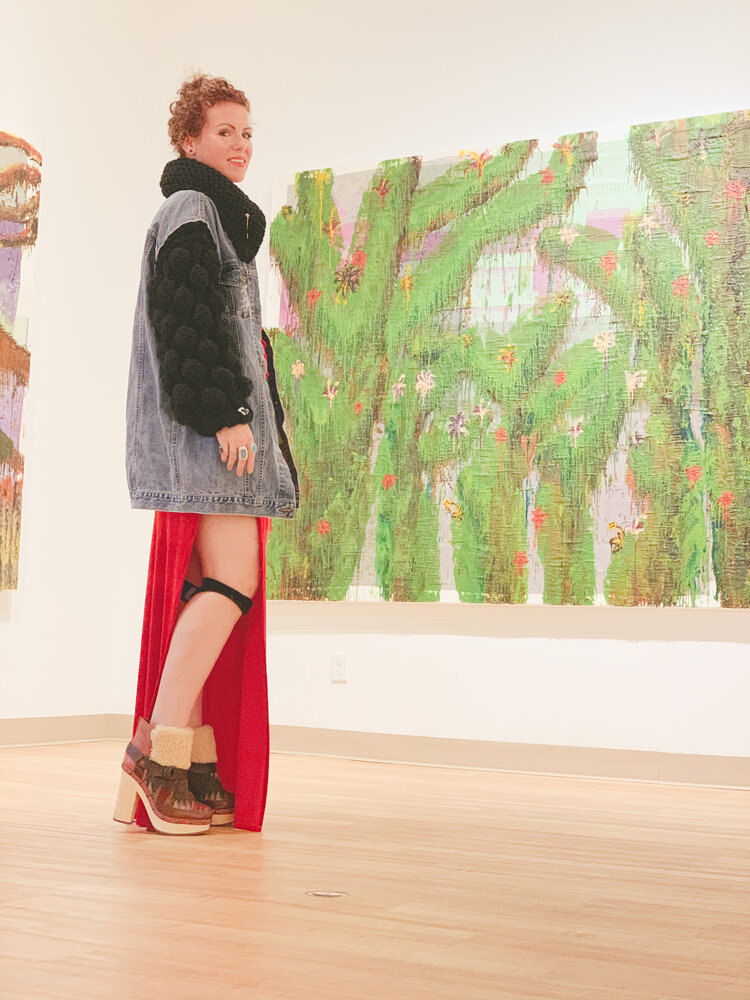
Portrait of Artist, Sideview, Daniella A. Colombo-Dougovito, Fall 2019.
References
American Psychiatric Association. (1968). Diagnostic and statistical manual of mental disorders (2nd ed.). Washington, D.C.: Author.
American Psychiatric Association. (1980). Diagnostic and statistical manual of mental disorders (3rd ed.). Washington, D.C.: Author.
Auenbrugger, L., & Neubruger, M. (1966). Inventum novum: A facsimile of the first edition with Covisart’s French translation (1808), Forbe’s English translation (1824), Ungar’s German translation (1843). London: Dawsons of Pall Mall.
Battesti, M. (2016). Nostalgia in the Army (17th-19th centuries). Frontiers of Neurology and Neuroscience, 38, 132-142.
Bovin, M. J., Marx, B. P., Weathers, F. W., Gallagher, M. W., Rodriguez, P., Schnurr, P. P., & Keane, T. M. (2016). Psychometric properties of the PTSD Checklist for Diagnostic and Statistical Manual of Mental Disorders–Fifth Edition (PCL-5) in veterans. Psychological Assessment, 28(11), 1379-1391. http://dx.doi.org/10.1037/pas0000254
C100. (2006). The art of rebellion 2: World of urban art activism. Mainaschaff, Germany: C100 Publikat.
Calvert, M. F. (2016, June). The battle within: Sexual assault in America’s military Part 2: The Survivors. Oral Presentation at Look3 Photography Festival, Charlottesville, VA.
Burchfield, C. (1947). Spring landscape with trees and pond [watercolor on paper]. DC Moore Gallery, New York.
Dayman, L., & Sandrey, D. (2018, February 9). 10 Japanese women artists you really should know. Retrieved February 16, 2019, from https://japanobjects.com/features/women-artists
Deleuze, G. (2014). Difference and repetition. New York, NY: Columbia University Press. Felton., D. (2014). The motif of the “mutilated hero” in Herodotus. Phoenix, 68(½), 47-61. doi: 10.7834/phoenix.68.1-2.0047
Goldsworthy-hanner, N. T. (2016, May 16). Personal interview (Unpublished). Goldsworthy-hanner, N. T. (2006). Arbitrary Memories [film photographs on canvas with acrylic and encaustic].
Hempel, A. G., Felthous, A. R., & Meloy, J. R. (2003). Psychotic dream-related agression: A critical review and proposal. Aggression and Violent Behavior, 8, 599-620. Hundertmark, C. (2006). The art of rebellion 2: World of urban art activism. Großostheim, Germany: Publikat.
John William Keedy’s “It’s Hardly Noticeable” series reveals our anxieties.(2013, July), Huff Post. Retrieved February 16, 2019, from http://www.huffingtonpost.com/ 2013/07/03/john-william-keedy-its-hardly-noticeable-photosn3540286.html
Kawauchi, R. (2016). The river embraced me. Tokyo: Torch Press. Kawauchi, R. (2016, January 1). The river embraced me. Retrieved February 16, 2019, from http://rinkokawauchi.com/en/publications/484/
Keedy, J. W. (n.d.) John William Keedy | It’s Hardly Noticeable. Retrieved February 16, 2019, from http://www.johnwilliamkeedy.com/itshardlynoticeable/#prettyPhoto
Mann, S., & Wood, J. (2005). Sally Mann: Photographs and poetry (Limited). South Dennis, MA: 21st Edition–Steven Albahari.
Mott, F. W. (1919). War neuroses and shell shock. New York: Oxford University Press. http// dx.doi.org/10.1037/14432-000
Norris Webb, R. (2012). My Dakota. Santa Fe, NM: Radius Books. Oxford University Press (1982). The compact edition of the Oxford English dictionary (22nd ed.). Oxford, UK: Author.
Schouten, K. A., de Niet, G. J., Knipscheer, J. W., Kleber, R. J., & Hutschemaekers, G. J. M. (2015). The effectiveness of art therapy in the treatment of traumatized adults. Trauma, Violence, & Abuse, 16(2), 220-228. https://doi.org/10.1177/1524838014555032
Thompson, N. (2015). Seeing power. Brooklyn, NY: Melville House. Webb, A., & Norris Webb, R. (2014). Alex Webb and Rebecca Norris Webb on street photography and the poetic image. New York: Aperture.
Weekly, N. (1993). Charles E. Burchfield: The sacred woods. Albany, NY: State University of New York Press.